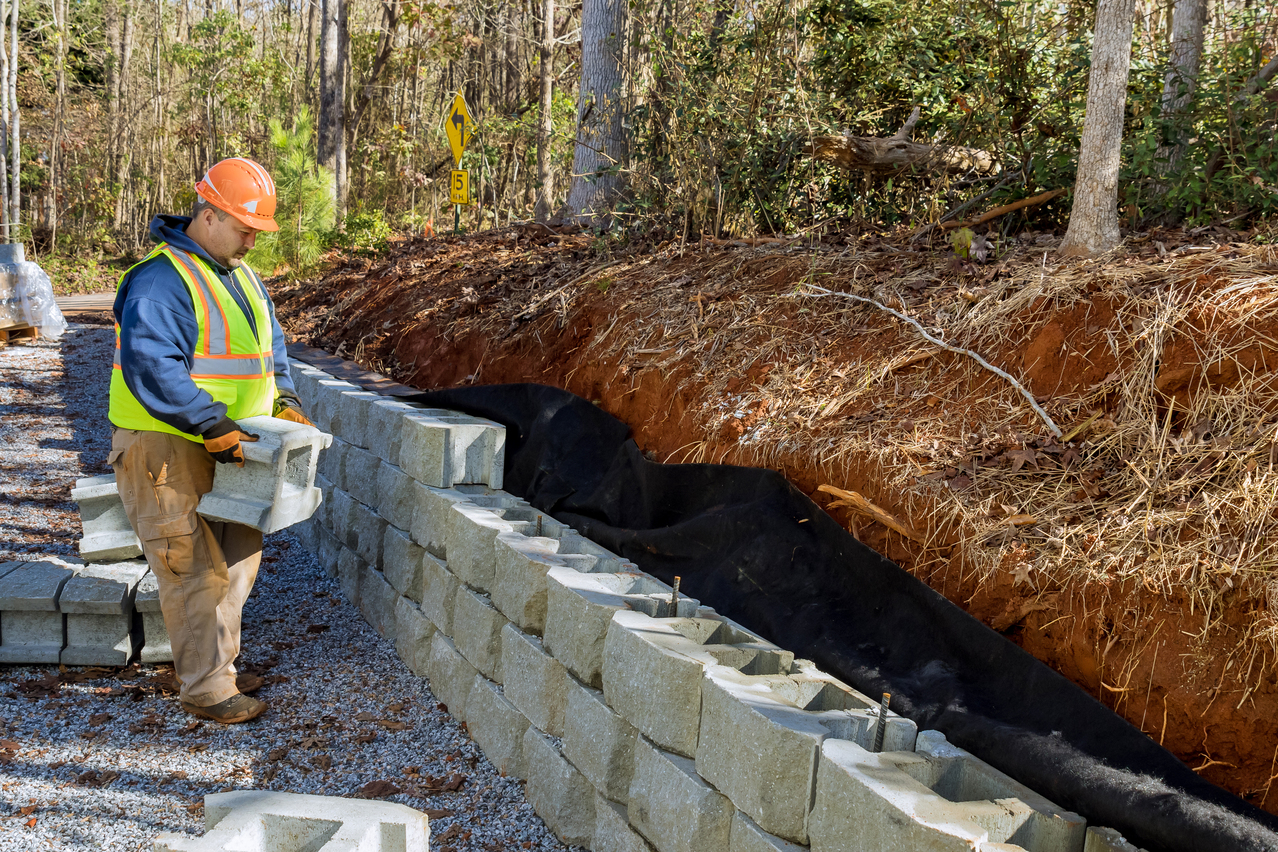SESI is hiring for Geotechnical, Environmental, and Site Civil positions. Apply Now!
The Role of Retaining Walls in Civil Engineering
March 01, 2025

Retaining walls play a critical role in modern civil engineering and construction. These structures are essential in preventing soil erosion, managing elevation changes, and ensuring the stability of landscapes and built environments. Whether utilized in large-scale infrastructure projects or private developments, retaining walls help engineers and developers maintain safe, functional, and aesthetically pleasing terrains.
SESI Consulting Engineers has been a leader in geostructural solutions for decades. Committed to innovation and collaboration, SESI delivers cost-effective, project-specific solutions that set it apart. This blog explores the importance of retaining walls, the key design considerations, and their diverse applications in civil engineering.
Understanding Retaining Walls and Their Function
Retaining walls are engineered structures that hold back soil and prevent slope failure. These walls are often essential in areas with significant elevation changes, where they stabilize the terrain and avoid erosion that could lead to costly damage or safety hazards.
Key Functions of Retaining Walls:
- Erosion Control: Retaining walls prevents soil displacement, especially in regions prone to heavy rainfall or seismic activity.
- Structural Support: These walls reinforce infrastructure by providing a stable foundation for roads, bridges, and buildings.
- Optimized Land Use: They enable construction on sloped terrains by creating level areas suitable for development.
- Aesthetic Enhancements: Many retaining walls serve dual purposes, providing functionality and aesthetic value in landscaping and urban design projects.
- Flood Control: In certain regions, retaining walls are essential in managing water flow and mitigating flood risks.
Planning and Design Considerations
Geotechnical Assessment and Site Analysis
Before constructing a retaining wall, a comprehensive geotechnical evaluation is necessary to understand the soil composition, load-bearing capacity, and groundwater conditions. SESI Consulting Engineers specializes in performing these evaluations, ensuring that retaining walls are designed for maximum stability.
- Soil Type Analysis: Identifying whether the soil is cohesive or granular affects drainage and load distribution. Expansive clay, for example, can lead to excessive wall movement, while sandy soil may require additional stabilization measures.
- Groundwater Impact: High water tables can exert hydrostatic pressure, requiring additional drainage solutions. Proper drainage prevents wall failure due to water buildup behind the structure.
- Load Considerations: Walls must be designed to handle lateral earth pressure and potential surcharges from buildings or vehicles. Heavy surcharges may require reinforced or anchored retaining walls to maintain structural integrity.
- Seismic Considerations: In earthquake-prone regions, additional reinforcement techniques such as geogrids or mechanically stabilized earth (MSE) may be necessary to prevent movement during seismic events.
Material Selection and Structural Design
The choice of materials significantly impacts the durability and functionality of retaining walls. Common materials include:
- Reinforced Concrete Walls: Durable and highly customizable for various designs. Reinforced concrete walls can handle higher loads and offer longer service life.
- Reinforced Earth Structures: Geogrids and soil reinforcement are used for increased stability. These walls provide cost-effective solutions for tall retaining structures and are commonly used by developers and homeowners.
- Gabion Walls: These structures use wire baskets filled with rocks and provide excellent drainage and flexibility. They are often used in riverbank stabilization and erosion control projects.
- Steel Sheet Pile Walls: A steel sheet pile retaining wall is a continuous barrier made of interlocking steel sections driven into the ground to hold back soil or water. It resists lateral pressures through the bending strength of the piles and may be used as a cantilever or with anchors/tiebacks for added support.
Segmental Blocks
Segmental retaining walls can generally be divided into two categories: small blocks and large blocks.
- Small Segmental Blocks: Typically about 12” wide by 8” high (the kind commonly available at home improvement stores), these blocks are ideal for landscaping and residential applications. They can be used for walls up to 4 feet tall without requiring reinforcement, as discussed in reinforced earth structures.
- Large Segmental Blocks: Examples include Recon and Redi-Rock blocks, which are often around 4 feet wide by 16” tall. These rely on their mass for stability and, with proper engineering, can be designed for walls exceeding 30 feet in height.
Types of Retaining Walls and Their Applications
Gravity Retaining Walls
These walls rely on their weight to resist lateral earth pressure. They are typically made from concrete, stone, or masonry blocks.
- Applications: All major wall types, including segmental blocks, gravity walls, and reinforced earth structures, can be used across a wide range of projects such as landscaping, highway embankments, and waterfront developments. The choice of which system to use often comes down to factors like construction cost, project timeline, and the desired aesthetics of the finished wall.
- Advantages: Gravity walls offer a unique benefit in cut situations, where excavation is required to reach the proposed grade. Because they can be constructed closer to a lot line, they reduce the amount of earthwork needed, which can offset their higher upfront cost compared to smaller block walls.
Cantilever Retaining Walls
Cantilever walls use a reinforced concrete base and leverage structural design to counteract soil pressure. They are commonly seen in large infrastructure projects.
- Applications: Roadways, commercial developments, and industrial sites.
- Advantages: These walls can be constructed as thin as 8 inches and placed directly on the lot line in a cut situation, where the adjacent grade is higher. This makes them an effective option for maximizing usable space on site.
- Limitations: They require steel inspection, concrete testing, and a footing that is buried deeper than other methods to account for freezing conditions. Typical footing depths are 3 to 4 feet based on local codes, compared to segmental walls that may require as little as 6 inches of burial.
Anchored Retaining Walls
These walls incorporate deep ground anchors, providing additional support for taller structures.
- Applications: Used in high-load conditions, such as deep excavations or waterfront projects.
- Advantages: Provides maximum stability with minimal footprint.
- Limitations: Higher installation costs and specialized construction techniques are required.
Mechanically Stabilized Earth (MSE) Walls
MSE walls use layers of reinforced soil with embedded geogrids or steel strips to create a stable structure.
- Applications: Highway embankments, bridge abutments, and large commercial developments.
- Advantages: Cost-effective and flexible for high walls, allowing for rapid construction.
- Limitations: Requires proper compaction and quality control during construction.
Construction and Implementation
Excavation and Foundation Preparation
Proper site preparation ensures that retaining walls perform as intended. This includes:
- Excavation: Removing unstable soil and preparing a level base. Excavation depths vary based on the type and height of the retaining wall.
- Drainage Solutions: Installing weep holes and/or perforated pipes to prevent hydrostatic pressure buildup. Without proper drainage, retaining walls may fail due to excessive water pressure.
- Reinforcement: Using steel, geogrids, or tiebacks for additional structural integrity. Reinforcement ensures the wall can withstand expected lateral loads and external forces.
Installation and Quality Control
Once the foundation is prepared, the retaining wall construction follows a structured approach:
- Layered Construction: Masonry or concrete blocks are stacked with proper compaction, ensuring alignment and stability.
- Backfill Compaction: Ensuring soil behind the wall is adequately compacted to avoid settlement issues and maintain wall integrity.
- Testing and Inspection: Engineers conduct load tests, soil stability analyses, and visual inspections to confirm structural integrity before finalizing the project.
Environmental Considerations and Sustainability
When designed with environmental impacts in mind, retaining walls can contribute to sustainable development. Considerations include:
- Eco-Friendly Materials: Using recycled concrete, sustainable timber, or other green building materials to minimize your environmental footprint.
- Biodiversity Integration: Designing walls that incorporate green terraces or vegetation to improve aesthetics and support local ecosystems.
- Stormwater Management: Retaining walls can be integrated with rainwater harvesting systems to control runoff and reduce soil erosion.
- Carbon Footprint Reduction: Implementing construction techniques that reduce emissions and reliance on non-renewable resources.
Conclusion
Retaining walls are indispensable in civil engineering, offering structural support, preventing erosion, and enabling efficient land use. SESI Consulting Engineers brings decades of expertise in designing retaining walls tailored to the unique needs of each project. By combining geotechnical analysis, material innovation, and construction best practices, SESI ensures that retaining walls provide lasting stability,cost-effective solutions and sustainable developments for developers and contractors.
SESI Consulting Engineers
Ready to optimize your project? Contact SESI Consulting Engineers today to schedule a consultation.




